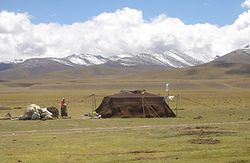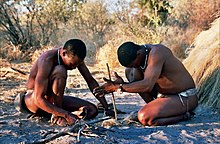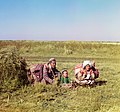Nomad
This article needs additional citations for verification. (July 2006) |


A nomad (Greek: νομάδες, nomádes, "those who let pasture herds"), commonly known as an itinerant in modern-day contexts, is a member of a community of people who move from one place to another, rather than settling permanently in one location. There are an estimated 30-40 million nomads in the world.[2]
Many cultures have traditionally been nomadic, but traditional nomadic behavior is increasingly rare in industrialized countries. Nomadic cultures are discussed in three categories according to economic specialization: hunter-gatherers, pastoral nomads, and "peripatetic nomads".
Nomadic hunting and gathering, following seasonally available wild plants and game, is by far the oldest human subsistence method. Pastoralists raise herds, driving them or moving with them, in patterns that normally avoid depleting pastures beyond their ability to recover. Peripatetic nomads, who offer the skills of a craft or trade to those with whom they travel, are most common in industrialized nations.
Common characteristics

Nomad is a person who moves from place to place as a way of obtaining food, finding pasture for livestock, or otherwise making a living. The word nomad comes from a Greek word that means one who wanders for pasture. Most nomadic groups follow a fixed annual or seasonal pattern of movements and settlements. Nomadic peoples traditionally travel by animal or canoe or on foot. Today, some nomads travel by motor vehicle. Most nomads live in tents or other portable shelters.
Nomads keep moving for different reasons. Nomadic foragers move in search of game, edible plants, and water. The Australian Aborigines, Negritos of Southeast Asia, and San of Africa, for example, traditionally move from camp to camp to hunt and to gather wild plants. Some American Indians followed this way of life. Pastoral nomads make their living raising livestock, such as camels, cattle, goats, horses, sheep, or yaks. These nomads travel to find water and pastures for their herds. Bedouin herders, for example, move camels, goats, and sheep through the deserts of Arabia and northern Africa. The Fulani and their cattle travel through the grasslands of Niger in western Africa. Some nomadic peoples, especially herders, may also move to raid settled communities or avoid enemies. Nomadic craftworkers and merchants travel to find and serve customers. They include the Lohar blacksmiths of India, the Romani (Gypsy) traders, and the Irish Travellers.
Most nomads travel in groups of families called bands or tribes. These groups are based on kinship and marriage ties or on formal agreements of cooperation. A council of adult males makes most of the decisions, though some tribes have chiefs.
Pastoral nomad societies can have large populations. One such society, the Mongols, gave rise to the largest land empire in history. The Mongols originally consisted of loosely organized nomadic tribes in Mongolia, Manchuria, and Siberia. In the late 12th century, Genghis Khan united them and other nomadic tribes to found an empire that eventually stretched the length of Asia. See Mongol Empire. The nomadic way of life has become increasingly rare. Many governments dislike nomads because it is difficult to control their movement and to obtain taxes from them. Many countries have converted pastures into cropland and forced nomadic peoples into permanent settlements.
Hunter-gatherers

Many groups of 'nomadic' hunter-gatherers (also known as foragers) moved from campsite to campsite, following game and wild fruits and vegetables. Hunting and gathering was the ancestral subsistence mode of Homo, and all modern humans were hunter-gatherers until around 10,000 years ago.
Following the development of agriculture, hunter-gatherers were displaced by farming or pastoralist groups in most parts of the world. Only a few contemporary societies are classified as hunter-gatherers, and many supplement, sometimes extensively, their foraging activity with farming and/or keeping animals.
Pastoralism



Pastoral nomads are nomads moving between pastures. Nomadic pastoralism is thought to have developed in three stages that accompanied population growth and an increase in the complexity of social organization. Karim Sadr has proposed the following stages:
- Pastoralism: This is a mixed economy with a symbiosis within the family.
- Agropastoralism: This is when symbiosis is between segments or clans within an ethnic group.
- True Nomadism: This is when symbiosis is at the regional level, generally between specialised nomadic and agricultural populations.
The pastoralists are sedentary to a certain area, as they move between the permanent spring, summer, autumn and winter (or dry and wet season) pastures for their livestock. The nomads moved depending on the availability of resources.[4]
Origin
Nomadic pastoralism seems to have developed as a part of the secondary products revolution proposed by Andrew Sherratt, in which early pre-pottery Neolithic cultures that had used animals as live meat ("on the hoof") also began using animals for their secondary products, for example, milk and its associated dairy products, wool and other animal hair, hides and consequently leather, manure for fuel and fertilizer, and traction.
The first nomadic pastoral society developed in the period from 8500-6500 BC in the area of the southern Levant.[citation needed] There, during a period of increasing aridity, PPNB cultures in the Sinai were replaced by a nomadic, pastoral pottery-using culture, which seems to have been a cultural fusion between a newly arrived Mesolithic people from Egypt (the Harifian culture), adopting their nomadic hunting lifestyle to the raising of stock.[5]
This lifestyle quickly developed into what Jaris Yurins has called the circum-Arabian nomadic pastoral techno-complex and is possibly associated with the appearance of Semitic languages in the region of the Ancient Near East. The rapid spread of such nomadic pastoralism was typical of such later developments as of the Yamnaya culture of the horse and cattle nomads of the Eurasian steppe, or of the Mongol spread of the later Middle Ages.[5]
Increase in the former Soviet Central Asia
One of the results of the break-up of the Soviet Union and the subsequent political independence and economic collapse of its Central Asian republics has been the resurgence of pastoral nomadism.[6] Taking the Kyrgyz people as a representative example nomadism was the centre of their economy prior to Russian colonization at the turn of the 20th century, when they were settled into agricultural villages. The population became increasingly urbanized after World War II, but some people continued to take their herds of horses and cows to the high pasture (jailoo) every summer, i.e. a pattern of transhumance.
Since the 1990s, as the cash economy shrank, unemployed relatives were absorbed back on the family farm, and the importance of this form of nomadism has increased. The symbols of nomadism, specifically the crown of the grey felt tent known as the yurt, appears on the national flag, emphasizing the centrality of their nomadic history and past in the creation of the modern nation of Kyrgyzstan.
Sedentarization
By 1920; nomadic pastoral tribes represented over a quarter of Iran's population.[7] Tribal pastures were nationalized during the 1960s. The National Commission of UNESCO registered the population of Iran at 21 million in 1963, of whom two million (9.5%) were nomads.[8] Although the nomadic population of Iran has dramatically decreased in the 20th century, Iran still has one of the largest nomadic populations in the world, an estimated 1.5 million in a country of about 70 million.[9]
In Kazakhstan where the major agricultural activity was nomadic herding,[10] forced collectivization under Joseph Stalin's rule met with massive resistance and major losses and confiscation of livestock.[11] Livestock in Kazakhstan fell from 7 million cattle to 1.6 million and from 22 million sheep to 1.7 million. The resulting famine of 1931-1934 caused some 1.5 million deaths: this represents more than 40% of the total Kazakh population at that time.[12]
In the 1950s as well as the 1960s, large numbers of Bedouin throughout the Middle East started to leave the traditional, nomadic life to settle in the cities of the Middle East, especially as home ranges have shrunk and population levels have grown. Government policies in Egypt and Israel, oil production in Libya and the Persian Gulf, as well as a desire for improved standards of living, effectively led most Bedouin to become settled citizens of various nations, rather than stateless nomadic herders. A century ago nomadic Bedouin still made up some 10% of the total Arab population. Today they account for some 1% of the total.[13]
At independence in 1960, Mauritania was essentially a nomadic society. The great Sahel droughts of the early 1970s caused massive problems in a country where 85% of its inhabitants were nomadic herders. Today only 15% remain nomads.[14]
As many as 2 million nomadic Kuchis wandered over Afghanistan in the years before the Soviet invasion, and most experts agreed that by 2000 the number had fallen dramatically, perhaps by half. The severe drought had destroyed 80% of the livestock in some areas.[15]
Niger experienced a serious food crisis in 2005 following erratic rainfall and desert locust invasions. Nomads such as the Tuareg and Fulani, who make up about 20% of Niger's 12.9 million population, had been so badly hit by the Niger food crisis that their already fragile way of life is at risk.[16] Nomads in Mali were also affected.[17]
Contemporary peripatetic minorities in Europe and Asia

"Peripatetic minorities" are mobile populations moving among settled populations offering a craft or trade.
Each existing community is primarily endogamous, and subsists traditionally on a variety of commercial and/or service activities. Formerly, all or a majority of their members were itinerant, and this largely holds true today. Migration generally takes place within the political boundaries of a single state these days.
Each of the peripatetic communities is multilingual; it speaks one or more of the languages spoken by the local sedentary populations, and, additionally, within each group, a separate dialect or language is spoken.[citation needed] The latter are either of Indic or Iranian origin,[citation needed] and many are structured somewhat like an argot or secret language, with vocabularies drawn from various languages. There are indications that in northern Iran at least one community speaks Romani language, and some groups in Turkey also speak Romani.
Dom people
In Afghanistan, the Nausar worked as tinkers and animal dealers. Ghorbat men mainly made sieves, drums, and bird cages, and the women peddled these as well as other items of household and personal use; they also worked as moneylenders to rural women. Peddling and the sale of various goods was also practiced by men and women of various groups, such as the Jalali, the Pikraj, the Shadibaz, the Noristani, and the Vangawala. The latter and the Pikraj also worked as animal dealers. Some men among the Shadibaz and the Vangawala entertained as monkey or bear handlers and snake charmers; men and women among the Baluch were musicians and dancers, and Baluch women also practiced prostitution. Jogi men and women had diverse subsistence activities, such as dealing in horses, harvesting, fortune-telling, bloodletting, and begging.[citation needed]
In Iran the Asheq of Azerbaijan, the Challi of Baluchistan, the Luti of Kurdistan, Kermānshāh, Īlām, and Lorestān, the Mehtar in the Mamasani district, the Sazandeh of Band-i Amir and Marv-dasht, and the Toshmal among the Bakhtyari pastoral groups worked as professional musicians. The men among the Kowli worked as tinkers, smiths, musicians, and monkey and bear handlers; they also made baskets, sieves, and brooms and dealt in donkeys. Their women made a living from peddling, begging, and fortune-telling.
The Ghorbat among the Basseri were smiths and tinkers, traded in pack animals, and made sieves, reed mats, and small wooden implements. In the Fārs region, the Qarbalband, the Kuli, and Luli were reported to work as smiths and to make baskets and sieves; they also dealt in pack animals, and their women peddled various goods among pastoral nomads. In the same region, the Changi and Luti were musicians and balladeers, and their children learned these professions from the age of 7 or 8 years.[citation needed]
The nomadic groups in Turkey make and sell cradles, deal in animals, and play music. The men of the sedentary groups work in towns as scavengers and hangmen; elsewhere they are fishermen, smiths, basket makers, and singers; their women dance at feasts and tell fortunes. Abdal men played music and made sieves, brooms, and wooden spoons for a living. The Tahtacı traditionally worked as lumberers; with increased sedentarization, however, they have taken to agriculture and horticulture.[citation needed]
Little is known for certain about the past of these communities; the history of each is almost entirely contained in their oral traditions. Although some groups—such as the Vangawala—are of Indian origin, some—like the Noristani—are most probably of local origin; still others probably migrated from adjoining areas. The Ghorbat and the Shadibaz claim to have originally come from Iran and Multan, respectively, and Tahtacı traditional accounts mention either Baghdad or Khorāsān as their original home. The Baluch say they[clarification needed] were attached as a service community to the Jamshedi, after they fled Baluchistan because of feuds.[18][19]
Gallery
-
Yeniche people in the 15th century
-
Kyrgyz nomads in the steppes of the Russian Empire, Uzbekistan, by pioneer color photographer Sergey Prokudin-Gorsky, c. 1910.
-
Tuareg in Mali, 1974.
-
Kyrgyz nomads, 1869-1870.
-
Nomads in the Desert (Giulio Rosati).
-
Gros Ventre (Atsina) American Indians moving camps with travois for transporting skin lodges and belongings.
-
House barge of the Sea Gypsies, Indonesia. 1914-1921
-
Photograph of Bedouins (wandering Arabs) of Tunisia, 1899
See also
Specific:
- Eurasian nomads for the historically and pre-historically important Horse People
- Mongol Empire
- Nomadic empires
- Nomadic tents
- Nomads of India
- Sea Gypsies
Concepts in industrialised societies:
References
- ^ In pictures: Tibetan nomads BBC News
- ^ NOMADS - The FACTS
- ^ BBC NEWS | In Pictures | Nenets, reindeer herders in the Siberian arctic
- ^ Nomads of the Middle East, David Zeidan, OM-IRC, 1995
- ^ a b Patterns of Subsistence: Pastoralism
- ^ Pastoral Livestock Development in Central Asia, FAO Rural Development Division
- ^ Persian & Iranian Nomads at Best
- ^ Censuses of Pastoral Nomads and Some General Remarks about the Census of Nomadic Tribes of Iran in 1998
- ^ Iran's nomads going extinct, Los Angeles Times, February 18, 2008
- ^ Kazakhstan Overview
- ^ The Silent Steppe. The Story of a Kazakh nomad under Stalin.
- ^ The Development of Kazakhstan during the Soviet period
- ^ The Middle East People Groups and Their Distribution, DAVID ZEIDAN, OM-IRC, 1995
- ^ Mauritania - POLITICAL POWER IN THE MID-1980s, U.S. Library of Congress
- ^ Severe Drought Driving Nomads From Desert, Los Angeles Times, June 30, 2000
- ^ Niger way of life 'under threat', BBC News, August 16, 2005
- ^ Mali's nomads face famine BBC News, August 9, 2005
- ^ Peripatetics of Afghanistan, Iran, and Turkey
- ^ Customary strangers: new perspectives on peripatetic peoples in the Middle East, Africa and Asia Edited by Joseph C. Berland and Aparna Rao
Further reading
- Oberfalzerova, Alena. (2006): Metaphors and Nomads, Triton, Prague. ISBN 80-7254-849-2
- Sadr, Karim. The Development of Nomadism in Ancient Northeast Africa, University of Pennsylvania Press, 1991. ISBN 0-8122-3066-3
- Cowan, Gregory. "Nomadology in Architecture: Ephemerality, Movement and Collaboration" University of Adelaide 2002 (available: http://hdl.handle.net/2440/37830 [1])
- Chatty, Dawn. Articles on Nomadic life (1983–2009)
- Chatwin, Bruce. The Songlines (1987)
- Deleuze and Guattari, A Thousand Plateaus (1980)
- Melvyn Goldstein: The Impact of China's Reform Policy on the Nomads of Western Tibet
- The Remote World of Tibet's Nomads
- Grousset, René. L'Empire des Steppes (1939) Template:Fr icon
- Michael Haerdter Remarks on modernity, mobility, nomadism and the arts
- Kradin, Nikolay. Nomadic Empires in Evolutionary Perspective. In Alternatives of Social Evolution. Ed. by N.N. Kradin, A.V. Korotayev, Dmitri Bondarenko, V. de Munck, and P.K. Wason (p. 274-288). Vladivostok: Far Eastern Branch of the Russian Academy of Sciences; reprinted in: The Early State, its Alternatives and Analogues. Ed. by Leonid Grinin et al. (р. 501-524). Volgograd: Uchitel', 2004.
- Kradin, Nikolay N. 2002. Nomadism, Evolution, and World-Systems: Pastoral Societies in Theories of Historical Development. Journal of World-System Research 8: 368-388.
- Kradin, Nikolay N. 2003. Nomadic Empires: Origins, Rise, Decline. In Nomadic Pathways in Social Evolution. Ed. by N.N. Kradin, Dmitri Bondarenko, and T. Barfield (p. 73-87). Moscow: Center for Civilizational Studies, Russian Academy of Sciences.
- Kradin, Nikolay N. 2006. Cultural Complexity of Pastoral Nomads. World Cultures 15: 171-189.
- Beall, Cynthia and Goldstein, Melvyn: Past becoming future gor Mongolian nomads National Geographic Magazine May 1993
- Vigo, Julian. 'Nomadic Sexualities and Nationalities: Postcolonial Performative Words and Visual Texts'. Inscriptions in the Sand Famagusta: Eastern Mediterranean University Press, 2005.










